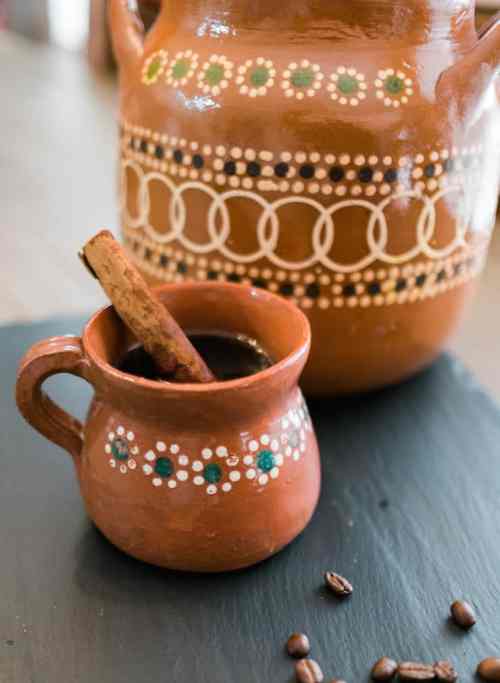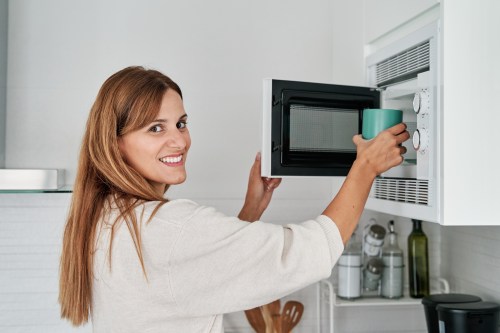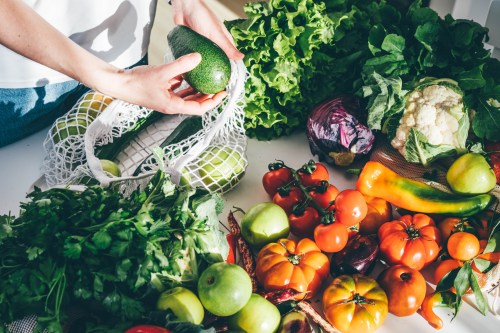Our editors independently select these products. Making a purchase through our links may earn Well+Good a commission
Baristas Report That This Is the Best (and Easiest) Way To Make Iced Coffee. After Hours of Testing, We Agree
We tried and tested two coffee-expert approved methods for making homemade iced coffee. Learn more about each of their pros and cons.

The weather plays a significant role in how I take my coffee—and when temperatures finally reach anywhere above the (very specific) temperature of 59°F, I like it ice-cold.
Experts in This Article
director of coffee, Partners Coffee
coffee expert and co-owner and founder of Bean &
The warmer months are high time for frequent iced coffee drink runs, but alas…anyone who relies on the stuff knows that all those $7 cafe-bought cups can quickly turn into a hefty monthly expense if it’s an everyday habit. To each their own, I say, but at the speed at which I sip my caffeine—and my lack of restraint to savor it—I’ve taken to making homemade iced coffee to help myself save money and time this summer.
You would think something so straightforward to make would require no instruction, but if you’ve ever tried making homemade iced coffee, you know that there’s a very strong (pun intended) chance that it can end up tasting like coffee-flavored water. Using the proper technique is a key way to avoid this. According to CEO and co-founder of Bean and Bean Coffee Roasters Jiyoon Han, and Partners Coffee director and coffee educator Cary Wong, there are two main methods to make iced coffee, and each come with their own pros and cons.
Before we get buzzed, a clarification: You can also opt to make iced coffee with cold brew. And while a viable option, iced coffee and cold brew aren’t one and the same. “Iced coffee is brewed hot and then chilled down. Cold brew is, like the name suggests, coffee that is brewed with cold or room-temperature water,” Han says. What’s more, cold brew is typically less acidic than hot-brewed coffee, while iced coffee will have less caffeine than its counterpart—these differences, however, are subtle.
Regardless of which iced-coffee method you choose, Han says you can use more coffee grounds than usual if you are unsure of the coffee-to-liquid ratio. “When in doubt, err on the side of brewing a coffee that is too strong to start since it will dilute over time,” she says. And don’t forget to chill a batch of coffee ice.
How to make homemade iced coffee using two methods
Method 1: Flash brew
The first method involves a “flash brew,” a popular technique long used in Japan, which results in what the Japanese refer to as Aisu Kohi or flash-chilled coffee. This entails “brewing hot coffee directly over ice,” says Han, and it is both her and Wong’s preferred method. “This creates a flavorful and bright iced coffee without the murky flavor you sometimes get from cooling a cup of hot coffee in the refrigerator,” says Wong. It typically requires a pour-over brewer—a tradeoff for those who don’t own this type of coffee maker at home.
“This creates a flavorful and bright iced coffee without the murky flavor you sometimes get from cooling a cup of hot coffee in the refrigerator,” says Wong.
I was new to this method before my test, so I followed a flash brew recipe from Baked Brewed Beautiful using the Hario V60 Ceramic Coffee Dripper Pour Over ($26). Sure enough, Han and Wong were spot-on: Flash brewing iced coffee produces a cup of coffee that is super smooth-tasting and naturally sweet, without any overly bitter aftertaste.
Flash brewing requires a long, constant spiral pour, which will either feel meditative or like extra work depending on your pre-caffeine state. For me, it was the former—and while not everyone will share this sentiment, the effort is well worth it. If you want to try this at home, my only recommendation is that you use large ice cubes while the coffee drips into your cup so they don’t melt as quickly.
Ingredients:
30 ounces ground coffee (medium-fine grind)230 ounces water150 grams ice cubes2 Tbsp milk (optional)
Materials:Pour-over brewerCoffee filterGooseneck kettle
1. Heat water in a kettle to a temperature of about 195°F to 205°F.
2. Place a coffee filter and moisten the filter with hot water.
3. Add ice cubes to a glass or cup, or, if using a Chemex, the carafe.
4. Add coffee grounds to the coffee filter bag.
5. Slowly pour water over the grounds in a circular motion to evenly saturate. Wait 30 seconds.
6. Repeat previous step with the remaining water until no more water runs from the kettle. Swirl to combine.
7. Discard the filter bag with the grounds, and decant the coffee into a glass with ice.
Get the recipe: Best Basic Iced Coffee Recipe
Method 2: Let coffee cool
The second method can be done with your preferred drip coffee machine or any other coffee maker. It’s pretty simple, too: Just brew your coffee as you normally would, let it cool, and then serve it with ice. Han says that you can also chill your coffee in the fridge if you’re in a time crunch.
The downside to this coffee-cooling method, as mentioned by Wong, is that it can result in a less-than-tasty cup. Han agrees: “The coffee can end up tasting stale and oxidized since it’ll need to sit for at least a few hours.” Since you’ll have to wait for the coffee to cool down, it’ll also require more time to prepare ahead.
“The coffee can end up tasting stale and oxidized since it’ll need to sit for at least a few hours,” says Han.
Because you can use your preferred coffee machine or maker for this method, I went straight to my trusty Bodum Caffettiera French Press ($28) and let the coffee grounds steep for four minutes in hot water (and not a second longer) before pouring my brew into a separate cup. To speed up the cooling process, I placed the cup in the fridge. It took about 20 minutes for it to cool to room temperature and I served it with a generous amount of ice.
While my coffee had that slightly “muddy” appearance that French press coffee is known for, it didn’t taste that way. It was pleasant with a punchy flavor. But in my opinion, it was less smooth and more bitter than the previous method. (Suppose this was to be expected.)
Generally, I think the flash brewing method of making iced coffee products a more balanced, less bitter cup—but that’s just my palate. If you’ve got the gear to execute it, even better. But you can’t beat the versatility of the coffee-cooling method. It’s really a matter of your priorities when it comes to caffeinating.
Ingredients:
Coffee groundsWaterIce cubes
1. Make hot coffee using your preferred method.
2. Pour coffee into mugs or a carafe, and let it cool to room temperature or refrigerate.
3. Once cooled, serve over ice.
How to upgrade your homemade iced coffee
An iced coffee is refreshing in itself, and while you can certainly enjoy it as is, it can also serve as a blank canvas for experimentation.
“Any way that you can typically jazz up a hot coffee will certainly also work with iced coffee,” says Han. This means a splash of milk or cream, or a hint of vanilla. According to Wong: “Another great way to flavor iced coffee is steeping the coffee along with other ingredients like mulling spices or cinnamon.”
The iced-coffee varieties you can make are endless. “Since iced coffee is cold, you do also have the possibility of experimenting with fresh garnishes like herbs or citrus that can add an interesting dimension,” says Han. “Flash-brewed coffees in particular tend to have brighter, more fruit-forward flavors—expressing a lemon peel onto an iced coffee like you would for a cocktail can be quite tasty!”
3 homemade iced coffee recipes to try
1. Iced honey lavender latte

This iced honey lavender latte from the Fork in the Kitchen has a distinctive taste that comes from the inclusion of lavender honey syrup. The syrup adds a hint of sweetness to the drink while helping balance out the natural bitterness of the coffee.
Get the recipe: Iced Honey Lavender Latte with Oat Milk
2. Vietnamese iced coffee

The White on Rice Couple’s Vietnamese iced coffee recipe calls for a phin filter, a traditional Vietnamese brew tool, but they also offer an alternative method for those with an espresso machine. The coffee is mixed with sweetened condensed milk—and together with ice, it can make for a refreshing pick-me-up.
Get the recipe: Traditional Vietnamese Iced Coffee
3. Café de olla

Café de Olla is a spiced coffee that originates from Mexico, and this version from Yvette Marquez of Muy Bueno can be served hot or over ice. It combines warming spices—namely, cinnamon, cloves, and star anise—with piloncillo (pure cane sugar), resulting in a coffee with a delicately sweet and toasty flavor.
Get the recipe: Café de Olla
Sign Up for Our Daily Newsletter
Get all the latest in wellness, trends, food, fitness, beauty, and more delivered right to your inbox.
Got it, you've been added to our email list.










